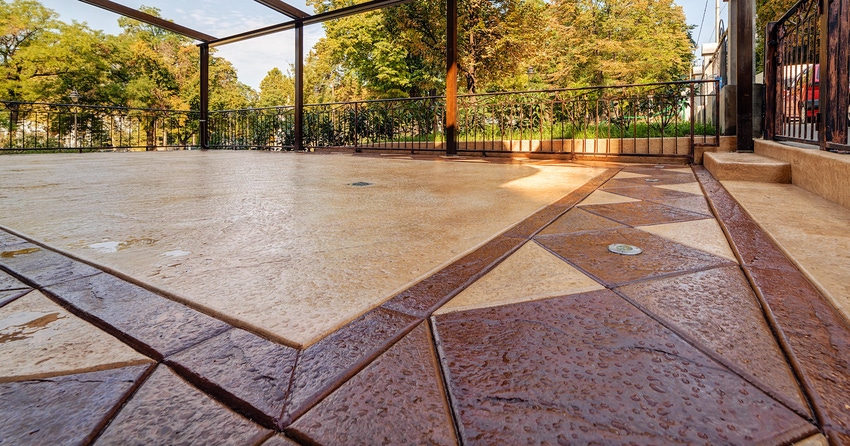Stamped concrete is in high demand for residential and commercial projects. Two pros provide best practices and expert tips.

Stamped concrete done right will wow your customers and can boost referrals and sales. Here, two stamped concrete experts from Patterned Concrete of Cincinnati provide techniques and tips for stamped concrete pros and those who are just getting started.
Paul Schneider, the firm’s owner who has worked with stamped concrete for decades, and his son Kris presented a thorough overview at the World of Concrete recently on prepping for a stamped concrete project and how to expertly stamp the slab.
(To learn about the prep, click here for technical information and tips from the Schneiders.)
Prior to stamping, inspect the overall finish of the concrete slab. It should not have float marks, the finish should be consistent across the surface and all edges should be finished.
When is the concrete ready to be stamped? Ask yourself these two questions:
Can the concrete support an individual’s weight on kneeboards?
How deep does the surface provide resistance? They suggested using the margin trowel test to figure this out.
If you are still unsure after answering these questions, start stamping from the edge to make a determination.
There are a few signs that you started stamping too soon:
The concrete sticks to the mat.
The mats are sliding as you walk on them.
The texture shows footprints or heel/toe marks.
The texture depth is inconsistent.
There also are clear signs that you started stamping too late and that you are “beating the curd out the process,” Paul Schneider said:
Aggressive texturing is needed from the beginning of the process.
The release color is not changing.
A tamper tool is needed from the start.
Kris Schneider said ideally you want to walk-in the texture at the beginning and transition to using a tamper in the middle.
Once you begin, stamp in the same order you poured the concrete. Place the stamps one row at a time and most important, check for proper alignment.
In addition to the alignment, consider how the stamps will meet formwork and walls.
Finally, keep the mats tight and avoid pattern repetition. Use a textured skin to finish the slab edges.
Stamping tips
Don’t rush the process, Paul Schneider warned. “My guys will say we gotta get going…but I say it’s gotta be done right.”
The presenters also said don’t rework the concrete where antique release has been applied because that will change the color. In addition, look for change in the release color, which tends to lighten up with proper texturing. If the release is not lightening up, it’s not deep enough. To fix these issues, you can apply finishing aids (but not water).
Use proper technique—tap, tap, rub, rub—when touching up areas by hand.
If you are using a seamless texture skin mat, apply the flip-and-flop method. Place the edge of a mat over the edge of another mat that already is in the surface. Then flip the mat edge that was down first on top of the stamp laid by the second mat to smooth out the hard-edge line.
Meanwhile, pay attention to sun and shade lines, especially if part of the project is under an awning or is shaded, and remember that concrete hardens faster outdoors.
Use a tamper for even texture. Plus, make sure finishing aids are color compatible and don’t use them if you have started applying the release.
A good rule of thumb is to have one worker per 100-square-foot pour, Paul Schneider said, adding his typical jobs include four to five people. While crew members have different tasks, “stamping is the responsibility of the entire team,” he said. “Everyone has got be focused.”
At the end of the stamping process, tape off or barricade the area. Even if the concrete is “as hard as possible,” a shoe or boot tread can be “silk-screened” into the surface.
Finally, clean up the jobsite. If you used a powder release, sweep the excess off the stamps, and limit foot traffic until the surface has been cleaned.
Cleaning the concrete
Cleaning the project includes scraping the joints, rinsing loose release and debris off the surface, acid washing and final rinsing, and touching up blowouts and surface cracks.
“This is what will make your customer want to pay you,” Kris Schneider said. “It’s the last detail.”
The Schneiders recommended waiting three to five days between making the last pour and cleaning to give the surface a chance to gain strength. When rinsing, remove loose release and debris and while the surface is damp, apply an acid wash to remove any remaining release.
The rinse should be a very weak acid solution, though—6 ounces of acid and one gallon of water. For best results, use a pump-up sprayer. After spraying, move the solution around with a broom and then rinse thoroughly.
“We need to do everything safely in this industry,” Paul Schneider said.
Sealing the stamped concrete
Kris Schneider said apply sealer to cure the concrete, enhance the color and protect the surface. “Before you put the sealer on, the concrete will look dull,” he noted.
The Schneiders described the two types of sealers—solvent and water based—and outlined their features and benefits.
Solvent-based sealers typically are used on decorative outdoor projects and make the finished area look wet. But they have limited use because of their high odor and flammability, and their sheen varies depending on the solids in the product.
Water-based sealers are ideal for indoor applications because they are low in odor, aren’t flammable, don’t make the surface look wet and generally have a lower sheen.
The presenters said that they are using siloxane-modified acrylic sealers because they offer the benefits of the solvent sealer and the penetrating capabilities of a siloxane sealer.
In terms of application, Kris Schneider said make sure the surface is clean and then apply two thin coats, paying attention to the manufacturer’s coverage rate. For best results, the sealer should be applied with a solvent-approved pump-up sprayer (but sealers can be rolled on or unsprayed and back-rolled, he said).
Also, don’t apply it to a hot slab or allow the sealer to bubble, and seal vertical surfaces before horizonal ones.
For best practices for preparing for a stamped concrete project provided by Paul and Kris Schneider during the same WOC session, click here.
Read more about:
decorative concrete equipment and materialsAbout the Author(s)
You May Also Like




